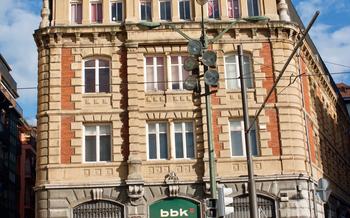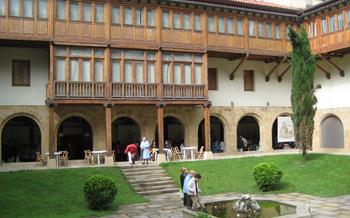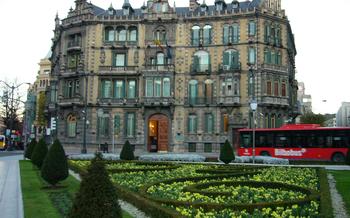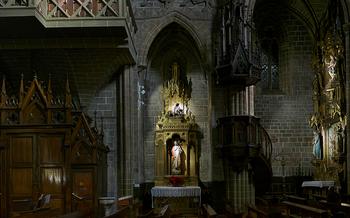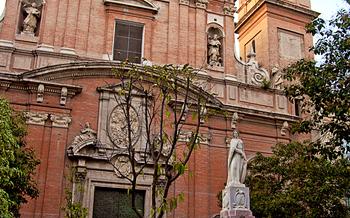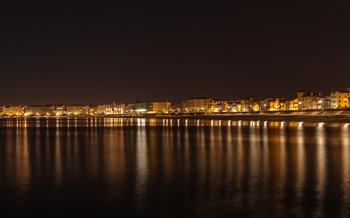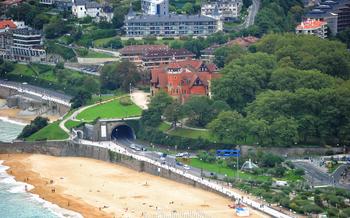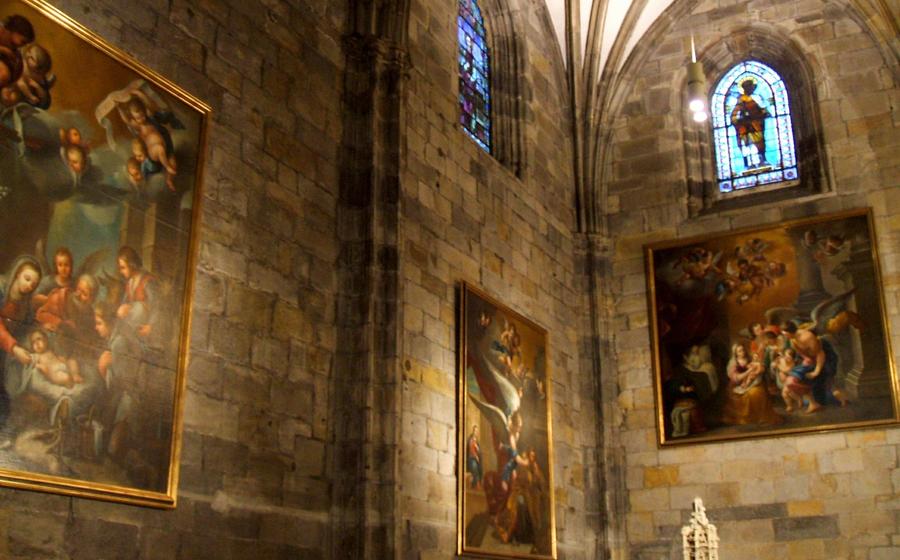
Basilica of Begoña
- Historical significance
- A Journey Through Time: History of the Basilica
- Architectural Masterpiece: Exploring the Exterior
- Devotion to the Virgin of Begoña
- Unveiling the Chapel of the Virgin
- Witnessing Faith: Attending a Service
- Exploring the Surroundings: Plaza de la Basílica
- Unlocking the Past: Museo de Pasos
- Bilbao's Religious Heritage: Other Churches
- Pilgrimage to Begoña: El Santo Rosario worship but also a destination for pilgrims. Every year, thousands of devotees embark on a spiritual journey known as El Santo Rosario. This pilgrimage traces the route of the Virgin Mary's statue from her original shrine in Santimamiñe to her current home in Begoña.
- Local Festivals and Events
- Bilbao's Culinary Delights
Historical significance
In the heart of Bilbao, Spain, stands the Basilica of Begoña, a majestic edifice that holds deep historical significance. For centuries, it has served as a spiritual beacon for the people of Bilbao, embodying their devotion and shaping the city's religious and cultural identity.
The origins of the basilica can be traced back to the 14th century, when a humble chapel was constructed on the site of a presumed apparition of the Virgin Mary. This miraculous event sparked a wave of devotion, transforming the chapel into a pilgrimage destination. As the city of Bilbao grew, so did the chapel, eventually evolving into the magnificent basilica that stands today.
Throughout history, the Basilica of Begoña has played a pivotal role in Bilbao's religious and civic life. It has hosted countless weddings, baptisms, and other significant events, witnessing the joys and sorrows of generations of Bilbainos. Its imposing presence has served as a symbol of hope and resilience during times of adversity, including the Spanish Civil War.
Today, the Basilica of Begoña remains a cherished landmark, drawing pilgrims, tourists, and locals alike. Its historical significance is woven into the fabric of Bilbao's identity, making it a must-visit destination for anyone seeking to understand the city's rich cultural heritage.
A Journey Through Time: History of the Basilica
The Basilica of Begoña's story is a fascinating journey through time, beginning in the 14th century when a humble chapel stood on the site. As devotion to the Virgin of Begoña grew, the chapel underwent several transformations, culminating in the construction of the current basilica in the 16th century.
The basilica's architectural evolution reflects the changing tastes and styles of different eras. Its Gothic-Renaissance fusion showcases the transition between medieval and Renaissance architecture. The striking façade, with its intricate carvings and sculptures, is a testament to the artistry of the Renaissance period. The ornate bell tower, added in the 17th century, further enhances the basilica's grandeur and serves as a symbol of Bilbao's growing importance.
Throughout its history, the Basilica of Begoña has played a pivotal role in Bilbao's development. It has witnessed the city's triumphs and tribulations, serving as a place of solace and spiritual guidance for its residents. Legends and stories abound about miracles and divine interventions attributed to the Virgin of Begoña, further solidifying her status as the city's beloved patron saint.
Architectural Masterpiece: Exploring the Exterior
The Basilica of Begoña stands as a testament to the fusion of Gothic and Renaissance architectural styles, showcasing a harmonious blend of grandeur and elegance. Its striking façade, adorned with intricate carvings and sculptures, captivates the eye, while the ornate bell tower, reaching towards the heavens, adds a touch of majesty to the skyline.
Elaborate sculptures grace the exterior walls, depicting biblical scenes and saints, each one a masterpiece in its own right, adding depth and symbolism to the basilica's façade. These sculptures not only serve as decorative elements but also provide a glimpse into the rich history and religious significance of the basilica.
Every detail of the basilica's exterior reflects the artistic prowess of its creators, showcasing the fusion of Gothic and Renaissance influences. The intricate carvings, the delicate tracery, and the harmonious proportions create a visual symphony that leaves visitors in awe.
Strolling around the basilica, one can appreciate the interplay of light and shadow, as the sun's rays dance across the ornate façade, casting intricate patterns on the ground below. The basilica's exterior is a true work of art, a testament to the skill and devotion of the artisans who brought it to life.
Devotion to the Virgin of Begoña
Patron Saint of Bilbao
The Basilica of Begoña holds a deep religious significance for the people of Bilbao, as it is dedicated to the city's patron saint, the Virgin of Begoña. This revered figure is deeply embedded in the cultural and spiritual fabric of the Basque metropolis. The Virgin of Begoña is believed to have intervened in several crucial moments of Bilbao's history, earning her the unwavering devotion of the local community.
Miraculous Image
The basilica houses a miraculous image of the Virgin Mary, which has become a symbol of hope and protection for the people of Bilbao. According to legend, the image was discovered in the 11th century by a shepherd who was led to it by a divine revelation. Since then, the image has been venerated by the faithful and is believed to possess miraculous powers.
Annual Pilgrimage
Every year, thousands of pilgrims flock to the Basilica of Begoña to pay homage to the Virgin Mary. The annual pilgrimage, known as the Romería de la Virgen de Begoña, is a testament to the enduring devotion of the Basque people. During the pilgrimage, the image of the Virgin is carried in a solemn procession through the streets of Bilbao, accompanied by music, prayers, and traditional Basque dancing.
Local Traditions and Celebrations
The devotion to the Virgin of Begoña is deeply intertwined with the local traditions and celebrations of Bilbao. The city's annual fiestas, known as the Aste Nagusia, culminate in a grand procession honoring the Virgin. This vibrant festival showcases Basque culture and heritage, with colorful costumes, traditional dances, and lively music filling the streets of Bilbao.
Unveiling the Chapel of the Virgin
At the heart of the Basilica of Begoña lies the Chapel of the Virgin, a sacred space dedicated to the patron saint of Bilbao. This exquisite chapel is a testament to the deep devotion and artistry of the Basque people.
Intricately designed and adorned with opulent decorations, the chapel exudes an aura of spirituality and reverence. The altar, a masterpiece of craftsmanship, features a resplendent image of the Virgin of Begoña, surrounded by intricate carvings and shimmering gold embellishments.
The tabernacle, a testament to the meticulous attention to detail, is a sight to behold. Its intricate design, featuring delicate filigree work and precious stones, reflects the profound respect and adoration held for the Virgin.
Veneration of the Virgin of Begoña is a central aspect of the religious life of Bilbao. The faithful gather in the chapel to pray, offer their gratitude, and seek her intercession. The atmosphere is palpable, filled with a sense of devotion and awe.
Witnessing Faith: Attending a Service
Step into the Basilica of Begoña during a religious service to witness the deep faith and devotion of the local community. Masses are held regularly throughout the week, offering visitors an opportunity to immerse themselves in the spiritual atmosphere of this sacred space. Experience the melodious hymns, the rhythmic prayers, and the heartfelt communion among the congregation. Observe the local customs and etiquette, such as standing during the Gospel reading and kneeling for the Eucharistic prayer. Partake in the rituals and ceremonies, feeling the sense of unity and reverence that permeates the basilica. It is a truly moving and enriching experience that provides a glimpse into the religious heart of Bilbao.
Exploring the Surroundings: Plaza de la Basílica
The Basilica of Begoña is beautifully situated in the heart of the Old Town, just a short walk from the city center. The Plaza de la Basílica, which fronts the basilica, is a charming and historically significant square that serves as a gathering place for locals and visitors alike. Surrounded by historical buildings, monuments, and sculptures, the plaza exudes an inviting atmosphere that invites exploration.
The most striking feature of the Plaza de la Basílica is the stunning ensemble of historical buildings that line its perimeter. These buildings, many of which date back to the 18th and 19th centuries, showcase a variety of architectural styles, from Baroque to Neoclassical, reflecting Bilbao's rich architectural heritage. Among the notable buildings are the Palacio de la Diputación (Provincial Government Building), the Teatro Arriaga (Arriaga Theatre), and the Palacio Consistorial (City Hall).
The plaza is further adorned with several monuments and sculptures that pay homage to important figures and events in Bilbao's history. The most prominent of these is the Monument to the Sacred Heart of Jesus, a majestic bronze statue that stands proudly in the center of the square. Other notable monuments include the Monument to Amadeo I and the Monument to the Battle of Luchana.
With its charming atmosphere, historical buildings, and significant monuments, the Plaza de la Basílica is a must-visit destination for anyone exploring Bilbao. Whether you choose to relax on a bench, admire the architecture, or soak up the vibrant atmosphere, the plaza offers a unique and enriching experience that complements a visit to the Basilica of Begoña.
Unlocking the Past: Museo de Pasos
Nestled within the premises of the basilica, the Museo de Pasos invites you on a journey through Bilbao's rich religious heritage. This captivating museum houses an impressive collection of religious artifacts, including intricately crafted procession floats and sculptures that have played a pivotal role in the city's processions and festivities.
Step inside to witness the artistry and craftsmanship that went into creating these magnificent floats. Admire the vibrant colors, intricate details, and lifelike figures that adorn each piece. Learn about the history and symbolism behind these religious processions, which have been an integral part of Bilbao's cultural and spiritual identity for centuries.
The museum also offers a glimpse into the local traditions associated with these processions. Discover the stories and legends surrounding the floats, and gain insights into the deep devotion and passion of the local community.
For a truly immersive experience, plan your visit during one of Bilbao's religious festivals, when these floats take center stage in grand processions that fill the streets with music, color, and devotion. The Museo de Pasos is a treasure trove of religious art and history, offering a unique opportunity to delve into the spiritual and cultural heart of Bilbao.
Bilbao's Religious Heritage: Other Churches
While the Basilica of Begoña stands as a testament to Bilbao's religious devotion, the city is home to a wealth of other churches that showcase its rich spiritual heritage. Each church possesses its own unique architectural style, historical significance, and cultural importance.
The Church of San Antón, located in the heart of the old town, boasts an impressive Gothic façade and a beautiful altarpiece. The Church of San Vicente, with its striking Renaissance architecture, is known for its elaborate stained glass windows and intricate carvings.
For those interested in modern religious architecture, the Church of La Sagrada Familia is a must-see. Designed by the renowned architect Josep María Sert, the church features a minimalist design and a stunning stained glass dome.
Bilbao's churches are not only architectural wonders but also play a vital role in the city's cultural and religious life. Many of these churches serve as venues for concerts, exhibitions, and other cultural events, fostering a vibrant connection between the sacred and the secular.
For pilgrims and religious tourists, Bilbao offers a unique opportunity to explore a diverse range of churches, each with its own story to tell. Whether you're seeking spiritual enlightenment or simply appreciating the beauty of religious architecture, Bilbao's churches are sure to leave a lasting impression.
Pilgrimage to Begoña: El Santo Rosario worship but also a destination for pilgrims. Every year, thousands of devotees embark on a spiritual journey known as El Santo Rosario. This pilgrimage traces the route of the Virgin Mary's statue from her original shrine in Santimamiñe to her current home in Begoña.
The pilgrimage dates back to the 16th century when the Virgin Mary is said to have appeared to a shepherdess in Santimamiñe. The shepherdess was instructed to take a statue of the Virgin to the top of Mount Begoña, where it would protect the people of Bilbao.
The pilgrimage route covers 25 kilometers and is divided into 15 stages. Each stage represents one of the mysteries of the Rosary, and pilgrims recite prayers and sing hymns along the way. The pilgrimage typically takes place in May and culminates with a grand celebration at the Basilica of Begoña.
For those seeking a unique and spiritual experience, El Santo Rosario is a must-do. It offers an opportunity to connect with the local culture, explore the Basque countryside, and deepen one's faith.
Local Festivals and Events
Bilbao and the Basilica of Begoña come alive during the annual festivals honoring the Virgin of Begoña. These vibrant celebrations showcase the city's rich cultural heritage and religious devotion. The most notable event is the Great Pilgrimage of El Santo Rosario, held every 15th of July. Thousands of pilgrims from across the Basque Country and beyond embark on a symbolic pilgrimage to the basilica, following the traditional route known as El Santo Rosario. The procession features colorful floats, traditional Basque music, and a sea of pilgrims dressed in white. It culminates in a solemn mass at the basilica, followed by lively festivities and cultural performances in the surrounding streets.
Another highlight is the Begoña Fair, held in mid-August. This lively fair transforms the area around the basilica into a bustling marketplace, filled with stalls selling local crafts, souvenirs, and traditional Basque delicacies. There are also amusement rides, games, and live music performances to entertain visitors of all ages. These festivals offer a unique opportunity to immerse yourself in Bilbao's vibrant culture and experience the deep devotion to the Virgin of Begoña firsthand.
Bilbao's Culinary Delights
A trip to Bilbao is incomplete without indulging in the city's renowned cuisine. Basque gastronomy is celebrated worldwide for its innovative techniques, fresh ingredients, and delectable flavors. To experience the authentic taste of Bilbao, venture into the narrow streets of the Old Town (Casco Viejo). Here, you'll find a treasure trove of traditional Basque restaurants, pintxo bars, and gourmet shops.
For a truly memorable dining experience, make sure to try some of the local specialties. Start your day with a hearty breakfast of "txakoli," a slightly sparkling white wine, accompanied by "pintxos," small snacks similar to tapas. Don't miss the chance to savor "bacalao al pil pil," a classic dish of codfish cooked in olive oil and garlic, or "chuleta," a succulent grilled steak.
If you're looking for a unique culinary adventure, head to the La Ribera Market, one of the largest covered markets in Europe. Here, you can browse a vast selection of fresh produce, seafood, and artisanal products. Indulge in local delicacies such as "pimientos de Gernika," a variety of green peppers, or "queso Idiazabal," a sheep's milk cheese.
Whether you prefer fine dining in Michelin-starred restaurants or casual meals in traditional taverns, Bilbao's culinary scene has something to offer every palate. Embrace the Basque passion for food and embark on a gastronomic journey that will leave your taste buds tingling.
